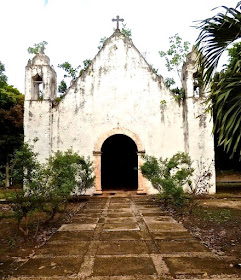Although the church was long ago stripped of its more perishable furnishings, two carved wooden beams from the choir loft have survived in place, all the more remarkable for their fine foliated decoration—a great rarity in Yucatán.*

The imposing sanctuary arch also remains, framing the remnants of a neoclassic stone retablo in the apse.
Although undocumented, some elements of fine stone carving in the church may represent more work by the talented Mayan sculptor Pascual Estrella, whose oeuvre we have described in earlier posts in this series.
The items in question are first, the elegant corbeled balcony below the choir window, a signature element in frontier church architecture, other examples of which are either attributed to or known to be the works of Maestro Estrella—at Chemax, Sabán and the especially ornate example at Petulillo's mother church of Peto.
 |
| Asunción Peto, the church front |
 |
| Peto, the carved choir balcony corbel |
A second and even more interesting item at Petulillo is the large baptismal font inside the church, which has miraculously survived the centuries, although now in two pieces.
The font is closely related in style and sculptural quality to Estrella’s other fonts at Chikindzonot, Hunucmá and Tihosuco. Around the broad basin, angels' heads float above a boldly carved thicket of luxuriant foliage and blossoms. And another carved cherub raises his arms in support on the detached base of the font.
text © 2018 Richard D. Perry
images by JB Johnson, Miguel Bretos, Edwin Baas Garcia and online sources
Please visit our other pages on the frontier churches of Yucatán:
Chemax; Chikindzonot; Ichmul; Sacalaca; Sabán; Peto/Petulillo; Huaymax/X-querol;
Please visit our other pages on the frontier churches of Yucatán:
Chemax; Chikindzonot; Ichmul; Sacalaca; Sabán; Peto/Petulillo; Huaymax/X-querol;




















































